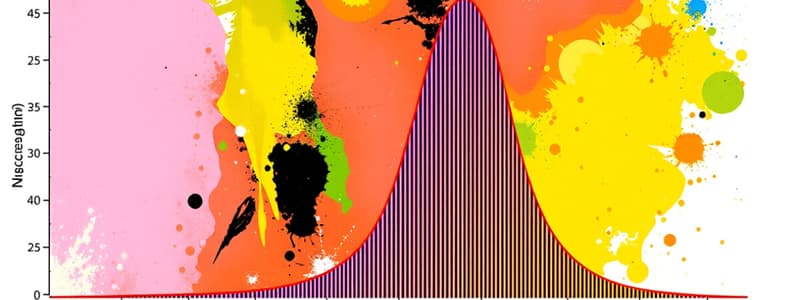Podcast
Questions and Answers
What does a Z-score of -2 indicate about a score?
What does a Z-score of -2 indicate about a score?
- The score is at the mean.
- The score is 2 standard deviations above the mean.
- The score is 2 standard deviations below the mean. (correct)
- The score is equal to the standard deviation.
Which percentage of data falls within 2 standard deviations from the mean in a normal distribution?
Which percentage of data falls within 2 standard deviations from the mean in a normal distribution?
- 68%
- 95% (correct)
- 99.7%
- 75%
In a stanine scale, a score that falls within which range indicates above average performance?
In a stanine scale, a score that falls within which range indicates above average performance?
- 4 to 6
- 7 to 9 (correct)
- 1 to 3
- 0 to 6
How is percentile rank calculated?
How is percentile rank calculated?
If a score has a Z-score of 0, what does that imply?
If a score has a Z-score of 0, what does that imply?
What does a percentile rank of 85 mean?
What does a percentile rank of 85 mean?
What is the total area under a normal distribution curve equal to?
What is the total area under a normal distribution curve equal to?
If a score falls in the stanine range of 4 to 6, how is the performance classified?
If a score falls in the stanine range of 4 to 6, how is the performance classified?
Study Notes
Statistical Concepts
Calculating Z-scores
- Definition: A Z-score indicates how many standard deviations an element is from the mean of a data set.
- Formula:
- ( Z = \frac{(X - \mu)}{\sigma} )
- ( X ) = raw score
- ( \mu ) = mean of the population
- ( \sigma ) = standard deviation of the population
- ( Z = \frac{(X - \mu)}{\sigma} )
- Interpretation:
- Z-score of 0 = score is at the mean.
- Positive Z-score = score above the mean.
- Negative Z-score = score below the mean.
Normal Distribution Properties
- Definition: A continuous probability distribution that is symmetrical about the mean.
- Key Properties:
- Mean, median, and mode are equal.
- The total area under the curve equals 1.
- Approximately 68% of data falls within 1 standard deviation from the mean.
- About 95% falls within 2 standard deviations.
- Nearly 99.7% falls within 3 standard deviations (Empirical Rule).
Stanine Interpretation
- Definition: A method of scaling test scores on a nine-point standardized scale.
- Scale:
- 1 to 3: Below average
- 4 to 6: Average
- 7 to 9: Above average
- Usage:
- Useful for comparing performance across different tests.
- Represents a student's relative standing compared to a normative sample.
Percentile Rank Calculation
- Definition: A statistical measure indicating the relative position of a score within a data set.
- Formula:
- ( P = \frac{(N_L + 0.5 \times N_E)}{N} \times 100 )
- ( P ) = percentile rank
- ( N_L ) = number of scores below the score
- ( N_E ) = number of scores equal to the score
- ( N ) = total number of scores
- ( P = \frac{(N_L + 0.5 \times N_E)}{N} \times 100 )
- Interpretation:
- A percentile rank of 70 means the score is higher than 70% of the scores in the data set.
Calculating Z-scores
- A Z-score quantifies how far a data point is from the mean in terms of standard deviations.
- The Z-score formula is ( Z = \frac{(X - \mu)}{\sigma} ), where ( X ) is the raw score, ( \mu ) is the mean, and ( \sigma ) is the standard deviation.
- A Z-score of 0 indicates a value that is exactly at the mean, while positive and negative scores indicate positions above and below the mean, respectively.
Normal Distribution Properties
- A normal distribution is a bell-shaped curve that is symmetric around the mean.
- In a normal distribution, the mean, median, and mode are identical.
- The total area under the normal distribution curve equals 1, representing the entire population.
- Approximately 68% of values lie within one standard deviation of the mean, while about 95% fall within two standard deviations, and nearly 99.7% fall within three standard deviations, following the Empirical Rule.
Stanine Interpretation
- Stanine scoring provides a way to scale test scores on a range from 1 to 9 for standardized performance evaluation.
- Scores in the range of 1 to 3 are considered below average, 4 to 6 are average, and 7 to 9 are above average.
- This method allows for comparison of performance across diverse tests and reflects a student's performance relative to a normative group.
Percentile Rank Calculation
- Percentile rank provides insight into the relative standing of a score within a data set.
- The formula for calculating percentile rank is ( P = \frac{(N_L + 0.5 \times N_E)}{N} \times 100 ), where ( N_L ) is the number of scores below the target score, ( N_E ) is the number of scores equal to the target score, and ( N ) is the total count of scores.
- A percentile rank of 70 indicates that the score is better than 70% of scores in the dataset, helping to contextualize performance.
Studying That Suits You
Use AI to generate personalized quizzes and flashcards to suit your learning preferences.
Description
This quiz covers essential statistical concepts including Z-scores, normal distribution properties, and stanine interpretation. Test your understanding of how to calculate Z-scores, interpret their significance, and recognize the characteristics of normal distribution. Ideal for students looking to master fundamental statistics concepts.




